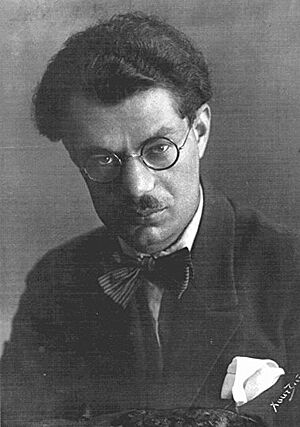Stratis Myrivilis facts for kids
Quick facts for kids
Stratis Myrivilis
|
|
|---|---|
| Στράτης Μυριβήλης | |

Stratis Myrivilis c. 1920s
|
|
| Born |
Efstratios Stamatopoulos (Ευστράτιος Σταματόπουλος)
30 June 1890 |
| Died | 19 July 1969 (aged 79) |
| Nationality | Greek |
| Other names | Stratis Myrivilis |
| Education | Gymnasium of Mytilene |
| Occupation | Writer |
| Era | Generation of the '30s |
| Known for | Life in the Tomb (1923-24, 1930) |
| Spouse(s) | Eleni Dimitriou |
| Children | 3 |
| Honours | Member of the Academy of Athens Thrice nominated for Nobel Prize in literature (1960, 1962, 1963) |
| Military career | |
| Allegiance | |
| Service/ |
|
| Rank | |
| Unit | 2nd Transport Hospital |
| Battles/wars |
|
| Signature | |
 |
|
Efstratios Stamatopoulos (born June 30, 1890 – died July 19, 1969) was a famous Greek writer. He wrote many novels, novellas (short novels), and short stories. He used the pen name Stratis Myrivilis. He was part of a group of writers known as the "Generation of the '30s". This group brought new ideas to Greek literature. He was even nominated three times for the Nobel Prize in Literature, which is a very important award.
Biography
Stratis Myrivilis was born in 1890 in a village called Sykaminea on the island of Lesbos. At that time, Lesbos was part of the Ottoman Empire. He spent his early years there.
In 1905, he moved to the town of Mytilene to study at a high school called the Gymnasium. After finishing school in 1910, he worked as a village school teacher for a year.
He then went to Athens University to study law. However, his studies were cut short because he decided to join the army. He volunteered to fight in the First Balkan War in 1912.
During the Second Balkan War, he was injured twice in the leg during the Battle of Kilkis–Lachanas. After these wars, Lesbos became part of Greece. Myrivilis returned home and became known for writing newspaper articles, poems, and stories.
In 1915, he published his first book, a collection of six short stories called Red Stories.
Myrivilis also served in World War I on the Macedonian Front. Later, he fought in the Asia Minor Campaign. He returned to Lesbos in 1922 after the war ended.
On June 28, 1920, he married Eleni Dimitriou. They had three children together.
From 1923 to 1924, Myrivilis published his famous World War I novel, Life in the Tomb, in a newspaper. A longer, updated version came out in 1930. This book made him famous across Greece.
Life in the Tomb showed his great skill as a writer. It was seen as a very important book that helped Greek prose writing grow and become more modern.
After the success of Life in the Tomb, Myrivilis moved to Athens. He worked as an editor for a newspaper called Demokratia. When the newspaper stopped publishing, he continued to write columns and short stories for other newspapers and magazines.
In 1936, he became the General Programme Director for the Greek National Broadcasting Institute. He held this job until 1951. During the German occupation, he resigned after a broadcast where he encouraged Greeks to keep resisting with dignity.
After the occupation, he worked at the Library of Parliament. In 1946, he helped start the National Society of Greek Writers and was chosen as its first president. During the Greek civil war, he strongly supported the government's side.
In 1958, Myrivilis became a member of the Academy of Athens. This was a big honor that recognized his important contributions to Greek literature. He had been nominated six times before finally being accepted.
Stratis Myrivilis passed away in an Athens hospital on July 19, 1969, after a long illness.
Major works
Novels
- Life in the Tomb (1923-4, 1930)
- The Schoolmistress with the Golden Eyes (1933)
- The Mermaid Madonna (1949)
Novellas
- Vasilis Arvanitis (1943, 1944)
- The Pagana (1945)
- Pan (1946)
Short story collections
- Red Stories (1915)
- Short Stories (1928)
- The Green Book (1936)
- The Blue Book (1939)
- The Red Book (1952)
- The Cherry Red Book (1959)
Translations into English
- Life in the Tomb translated by P. Bien (1977)
- The Schoolmistress with the Golden Eyes translated by Philip Sherrard (1964)
- The Mermaid Madonna translated by Abbot Rick (1959)
- Vasilis Arvanitis translated by Pavlos Andronikos (1983)
- The Step-daughter (short story) translated by Theodore Sampson (1981)
- The Cat's Eye (short story) translated by Irvin Ziemann (1969)
See also
 In Spanish: Stratis Myrivilis para niños
In Spanish: Stratis Myrivilis para niños

